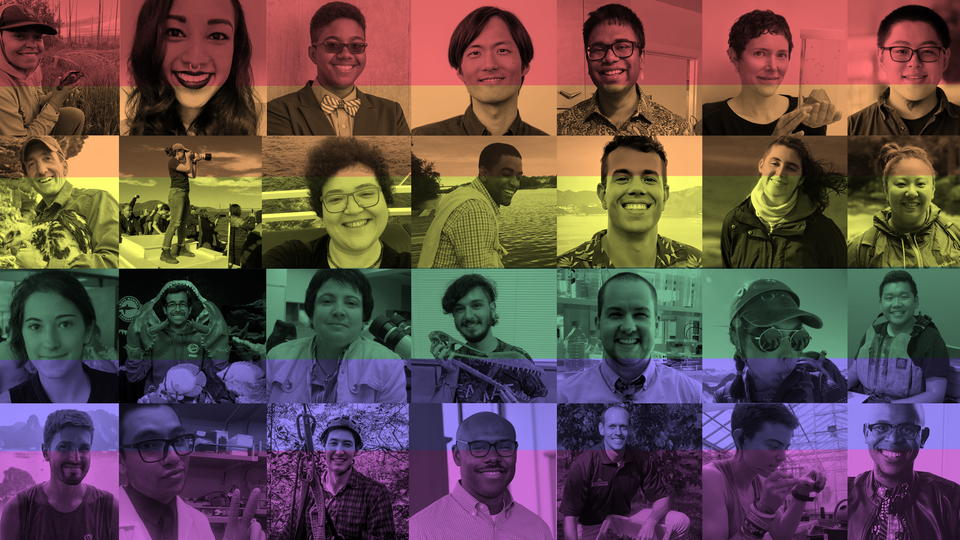
Being out in STEM
Hey there! I’m Roger Barrett, Design Director here at the Science Museum of Minnesota, and I have an awesome job. My job is designing museum experiences for the Science Museum here in St. Paul, and in partnership with other museums around the world.
I’m immensely proud to work in a STEM field (I do a surprising amount of geometry on a daily basis), and especially proud that my work is able to bring the truth of science to so many people. I’m also proud to identity as a gay man. While the LGBTQ+ community has seen significant advances in our rights over the past few years (I never thought I’d utter the words “my husband” in my lifetime!), there is still work to be done—including making sure that out LGBTQ+ individuals feel welcome working in STEM. I’m fortunate that the Science Museum has fostered a culture of inclusivity that welcomes me and my LGBTQ+ colleagues.
Do you work in STEM and want to share your story? 500 Queer Scientists aims to bring visibility to LGBTQ+ folks working in STEM fields. This project was started by two scientists working at the California Academy of Sciences, entomology curator Dr. Lauren Esposito and scientific illustrator Sean Edgerton.
Some sobering facts that 500 Queer Scientists has compiled:
There are still 28 states in the US where it’s legal for employers to discriminate against employees because of their sexual orientation or gender identity.
According to a 2013 survey of STEM professionals, nearly 40 percent of people who identified as LGBTQ+ were not out to their colleagues.
A 2014 study of STEM faculty at universities found that 69.2 percent of out faculty felt uncomfortable in their departments, and those who were out were more than 7 times more likely to be excluded by their colleagues.
In 2016, Chemical Engineering and News ran an informal poll of its readers to gain more information about the experiences of LGBTQ+ people in the field of chemistry. Out of 270 respondents, 44 percent said they felt excluded, intimidated, or harassed at work.
The Association of American Universities’ Climate Survey on Sexual Assault and Sexual Misconduct reported that 60 percent of LGBTQ+ students reported incidences of sexual misconduct and harassment—only 45 percent of their heterosexual classmates did the same.
That same survey reported that transgender, genderqueer, and gender non-conforming students reported the highest levels of on-campus sexual assault and misconduct.
A study of LGBTQ+ professionals published in 2019 found that “heteronormative assumptions frequently silence conversations about gender and sexuality in STEM workplaces and result in complicated negotiations of self for queer professionals.”
Out in STEM (oSTEM).
National Organization of Gay and Lesbian Scientists and Technical Professionals.
Sources:
[1} Jeremy B. Yoder & Allison Mattheis. (2016) Queer in STEM: Workplace Experiences Reported in a National Survey of LGBTQA Individuals in Science, Technology, Engineering, and Mathematics Careers. Journal of Homosexuality, 63:1, 1–27, DOI: 10.1080/00918369.2015.1078632
[2} Eric V. Patridge, Ramon S. Barthelemy, Susan R. Rankin. (2014) Factors Impacting the Academic Climate for LGBQ STEM Faculty. Journal of Women and Minorities in Science and Engineering, 20:1, 75–98, DOI: 10.1615/JWomenMinorScienEng.2014007429
[3} Linda Wang. (2016) LGBT chemists seek a place at the bench. Chemical Engineering and News, 94:41, 18–20.
[4} Association of American Universities (2015) Climate Survey on Sexual Assault and Sexual Misconduct
[5} Allison Mattheis, Daniel Cruz-Ramírez De Arellano & Jeremy B. Yoder (2019) A Model of Queer STEM Identity in the Workplace, Journal of Homosexuality, DOI: 10.1080/00918369.2019.1610632